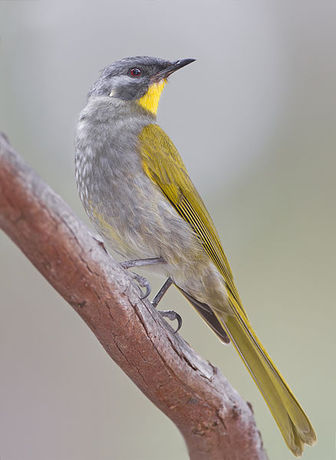Yellow-throated Honeyeater
The species was originally described by French ornithologist Louis Jean Pierre Vieillot in 1817, who originally placed it in the genus Melithreptus. Its specific epithet is derived from the Latin words flavus yellow, and collis neck. Other vernacular names are the Green Cherry-picker, Green Dick or Green Linnet.

Original source: JJ Harrison (http://www.noodlesnacks.com/)Camera location
Author: JJ Harrison (http://www.noodlesnacks.com/)Camera location
The Yellow-throated Honeyeater is classified as Least Concern. Does not qualify for a more at risk category. Widespread and abundant taxa are included in this category.
The Yellow-throated Honeyeater can be quite aggressive towards other honeyeaters, as well as other species such as pardalotes, Golden Whistlers and Grey Shrike-thrushes, chasing them away in both breeding and non-breeding seasons. Facts and figures Research Species: No Minimum size: 18 cm Maximum size: 23 cm Average size: 21 cm Average weight: 31 g Breeding season: August to December Clutch size: Usually two to three, up to five. More
A fact from Yellow-throated Honeyeater appeared on Wikipedia's Main Page in the Did you know? column on 28 February 2009, and was viewed approximately 2726 times (disclaimer) (check views). The text of the entry was as follows: "Did you know * ... that the Yellow-throated Honeyeater is known for collecting hair from live animals such as horses, dogs and humans for lining its nest?" Wikipedia Retrieved from "http://en.wikipedia. More
The Yellow-throated Honeyeater is a medium sized honeyeater with a relatively long tail. Typical weight is 31 g and the average length is 21 cm. The plumage is bright olive green above, with a silver-grey crown, face, and underbelly contrasting with a distinctive bright yellow chin and throat. There is a small yellow ear-patch and the wing feathers are outlined with yellow. The bill is black and the eye is a deep ruby red. Females are smaller than males. More
Yellow-throated Honeyeater Lichenostomus flavicollis = Described by: Vieillot (1817) Alternate common name(s): None known by website authors Old scientific name(s): Meliphaga flavicollis Photographs Mount Wellington, Tasmania, Australia - Feb, 2006 More
The yellow-throated honeyeater is common throughout Tasmania. Its preferred habitat is eucalypt forest, where it feeds on seasonally available nectar and insects. It is about 20 centimetres (eight inches) tall, with a blackish face and upper breast, offset by a bright yellow throat. It has a number of calls: 'tonk, tonk, tonk'; 'tchook, tchook'; 'chur-uk, chur-uk' and also 'pick-em-up'. More
Yellow-throated Honeyeater ( Lichenostomus flavicollis ) = Yellow-throated Honeyeater | Lichenostomus flavicollis photo Yellow-throated Honeyeater, Tasmania. Photograph copyright: Nickolay Tilcheff - all rights reserved. Used with permission. Yellow-throated Honeyeater | Lichenostomus flavicollis photo Yellow-throated Honeyeater, Tasmania. Image by KeresH - License: Public Domain. Amazon. More
Yellow-Throated Honeyeater, Lichenostomus flavicollis = Yellow-throated honeyeaterYellow-throated Honeyeater (Photography by Dave Watts) Description The endemic Yellow-throated Honeyeater is a common resident throughout Tasmania. It is a medium sized bird, up to 210mm, with olive-green colouring on the wings and back and speckled yellow-grey underparts. The dark grey crown and face contrasts with a rich yellow chin and throat. Females are smaller than males. More
Yellow-throated honeyeater Lichenostomus flavicollis This is a reasonably common honeyeater in most habitats within Tasmania. It is a bird of 18-22 cm with a dark grey crown, face and upper breast. It also has a silver grey cheek. Its distinctive yellow throat and yellowish under tail feathers identify this bird although immature birds have much lighter colours. It takes insects from foliage, probes bark. It also feeds on nectar and the manna of lerps on eucalypts. More
Family : Meliphagidae
Genus : Lichenostomus
Species : flavicollis
Authority : (Vieillot, 1817)

